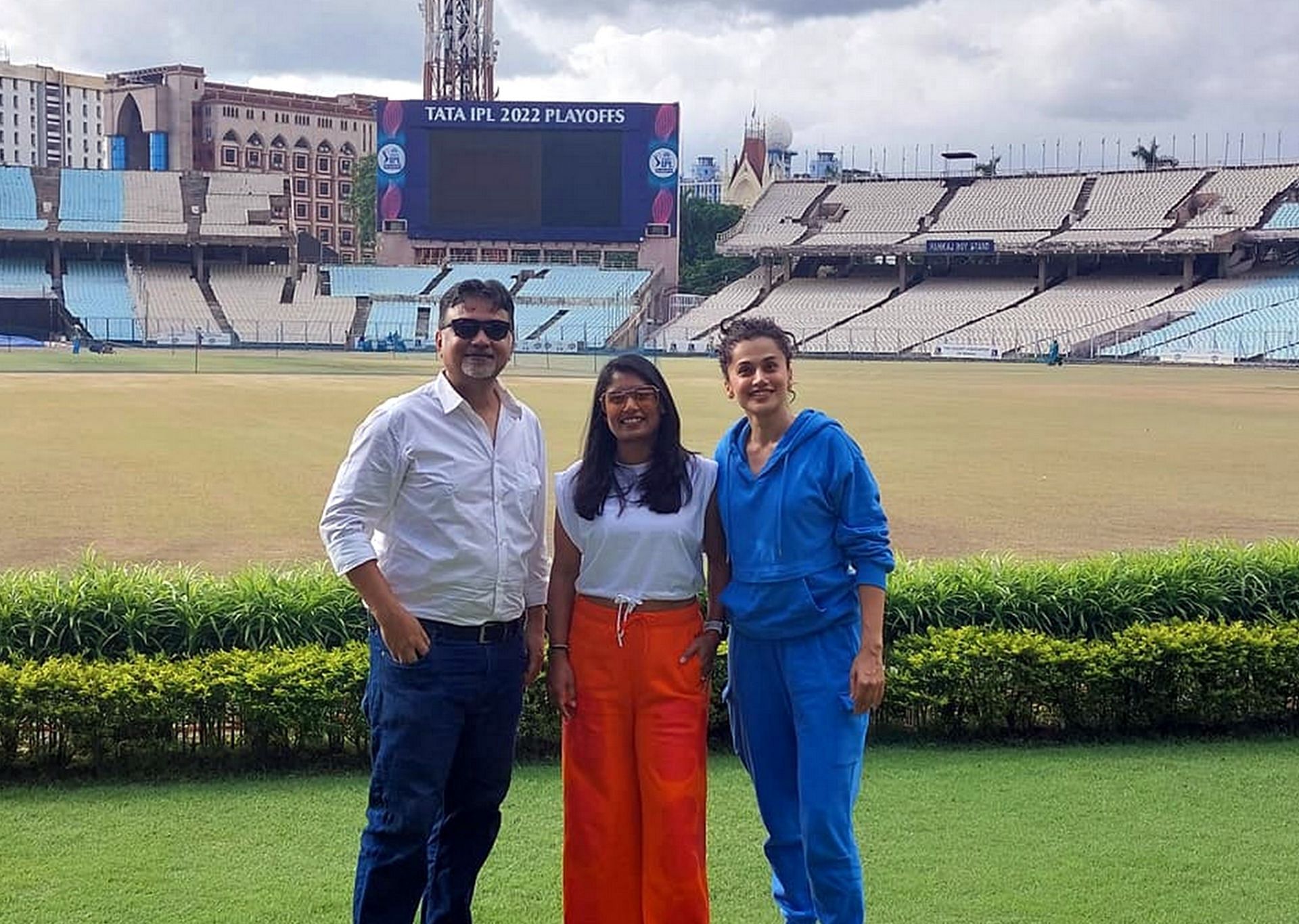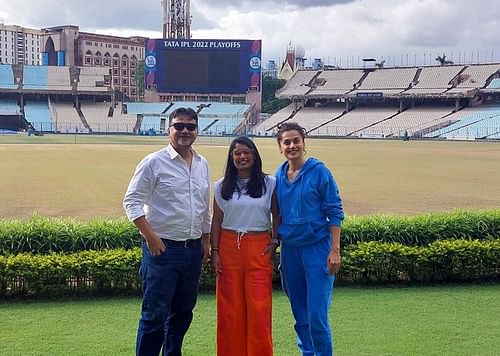
“The satisfaction when she found the sweet spot of her bat was organic” – Shabaash Mithu director Srijit Mukherji explains how Taapsee Pannu managed to ape Mithali Raj’s batting style

Mithali Raj is a female batting colossus to have emerged from a country where cricket is a religion and male players are put on a pedestal. Today, an ICC Women’s World Cup match featuring India can record over a million views on a leading OTT platform. However, not too long ago, the very idea of girls sporting flannels and playing the ’Gentleman's Game' was jeered as women’s cricket continued to reel under years of subjugation.
Notwithstanding her numerous batting records and successful captaincy tenure, Mithali’s legacy is defined by her role in changing the face of women’s cricket in India. She got into the game without chasing the fame or the wealth that the new crop of female cricketers aspires to. Her passion was genuine and her desire to excel was so strong that she established herself as a household name at a time when women’s cricket was not even telecast in India.
During her storied international career spanning 23 years, Mithali, along with Jhulan Goswami, was at the vanguard of the struggle that transformed women’s cricket in India into a lucrative profession. Female cricketers no longer have to live in the shadows of their male counterparts. They now have their own identity and are entitled to the same facilities as the men's team.
The 2017 ICC Women’s World Cup proved to be a catalyst for change even though Mithali and Co. narrowly lost to England in the final. Ten more runs would’ve secured India her maiden Women’s World Cup title, but it was nonetheless a watershed moment for Indian women’s cricket as the entire nation was immersed in the ‘Women in Blue’ dream.
Shabaash Mithu, a biographical drama that chronicles the rags-to-riches story of Indian women’s cricket through Mithali’s life, hit theaters on July 15 (Friday), after several Covid-enforced delays. Directed by Srijit Mukherji and starring Taapsee Pannu in the lead, the film, as the makers suggest, is more about the Women in Blue’s ascendancy than the protagonist’s personal struggles.
Ahead of the release of Shabaash Mithu, SK POP caught up with Srijit as the National Award-winning director narrated his earliest memory of women’s cricket, how Taapsee managed to ape Mithali’s signature shots, and his experience of shooting at the iconic Lord’s Cricket Ground. A bona fide cricket buff, Srijit’s knowledge of the sport can give any seasoned quizzer a run for their money.
Here are the excerpts:
Q: Rahul Dholakia was supposed to direct Shabaash Mithu before you replaced him. How challenging was it to take over the reins of a film whose production had already begun?
Srijit: It wasn’t a challenge at all because only eight days of shooting had happened, mostly with the kid Mithali and some practice sessions. I changed the entire plan of how the climax was to be shot. I opted for the footage approach as I thought it would be infeasible to shoot live-action for an entire tournament like the World Cup.
Plus, given the way our eyes have been conditioned to watch cricket telecast, it [shooting live-action] would’ve been absolutely impossible, even more so during the pandemic. It was more of a logistical change. In regards to the script, there were certain emotional scenes that came back after being chopped off.
Q: What is your earliest memory of Indian women’s cricket?
Srijit: I remember reading an article about Sandhya Agarwal in Ananda Mela as an adolescent. She was touted as the Sunil Gavaskar of women’s cricket at the time. As I grew up, I became increasingly passionate about cricket. I was a pace-bowling all-rounder in my childhood before turning into a wicketkeeper for my university team (smiles radiantly). Gradually, cricket became an obsession for me and I started reading extensively about the sport.
I’m a huge fan of Belinda Clark, Ellyse Perry, our own Mithali Raj, Jhulan Goswami, and more recently Smriti Mandhana. I do feel that women’s cricket has come a long way after a prolonged struggle. The journey has been tough, but things have been changing rapidly since the 2017 Women’s World Cup.
Q: Women’s matches were not telecast in India in the early 2000s. How difficult was it to portray Mithali’s formative years as a batter, given that you had little or no footage to rely upon?
Srijit: It was extremely difficult, but Mithali came to our rescue via Zoom calls. She was playing an international series at the time, so she was in a bio-bubble. Mithali’s friend and former teammate Nooshin Al Khadeer trained Taapsee for the role and I discussed with her the evolution of Mithali’s stance, grip and strokeplay.
I also went to the BCCI headquarters multiple times to dig up rare footage. I saw a good amount of footage that gave me a rough idea of how Mithali’s batting style has evolved over the years.
Q: I spoke to Mithali a couple of weeks back and she said she wanted Taapsee to master the cover drive, the shot she’s most identified with. Talk us through Taapsee’s training process.
Srijit: Taapsee had never a picked up a cricket bat before, so it was quite a challenge. I told her about my passion for cricket and cinema. I wanted her to perfect the art of batting. We were training with state-level players, so we obviously couldn’t limit ourselves to the cover drive.
The actors, most of whom are state-level players, bowled at various speeds and lengths, mixing up full-length and short balls. Hence, Taapsee was required to possess at least four to five shots in her arsenal. We started with the cover drive before moving on to the straight drive, pull, square cut and backfoot punch.
In most cricket-oriented films, deliveries are created through a lot of editing. For example, the bowler bowling is one angle, the delivery pitching is another angle, the batter hitting the ball is another angle, and so on. I wanted to take as many single takes as possible so that I didn’t have to depend on editing to create cricketing action.
My aim was to make my protagonist play cricket. So you had state-level bowlers bowling to Taapsee and Taapsee actually hitting them for boundaries through the covers. I was very impressed with Taapsee’s hard work and she fell in love with the game. The satisfaction when she found the sweet spot of her bat was organic.
Q: Mithali’s autobiography, Unguarded, is likely to be launched later this year. Did you refer to its draft for your research?
Srijit: The script for the film was complete before I came on board. Priya Aven, who wrote the screenplay, had shadowed Mithali for some time and a lot of research had gone in there.
Priya interviewed Mithali, her parents, and her friends to gather background information. I don’t think she referred to the autobiography as the person herself was there to share the background stories and approve whatever dramatization or fictionalization happened.
Q: Most biopics tend to either follow the underdog-struggle-victory template or whitewash the subject’s image. Is Shabaash Mithu any different from these templates?
Srijit: Firstly, Shabaash Mithu is not technically a biopic. It’s a biographical drama that speaks about the evolution of women’s cricket in India through the life of Mithali Raj. It’s macro and micro at the same time. One of the main reasons why I got attracted to the film is that it averts the usual underdog story of hitting a six and winning a match off the last ball.
Mithali’s life isn’t a typical underdog story. She comes from a relatively affluent background and her parents were supportive of her decision to become a cricketer. Although the usual underdog element may not be there, we’ve adopted a different approach to tell her story, which makes the film unique.
Q: There’s a perception in the media that Mithali is haughty and throws tantrums. How did you perceive her before and after meeting her?
Srijit: My perception hasn’t changed at all. I’ve always considered Mithali to be a reserved person. She’s definitely fun-loving, but doesn’t go over the top. I mean, have you ever seen a cricketer read Rumi before going out to bat (laughs)? She has a very strong personality.
We’ve had a blast during the promotions. She has been very jovial and accessible. That’s exactly what I imagined her to be. Her observations have a lot of depth. We’ve also discussed some selectorial decisions that have been made in Indian cricket of late. You get a taste of her cricket acumen when you discuss such issues with her. It has been an experience of a lifetime promoting a film alongside Mithali and getting to know her from such close quarters.
Q: I assume the climax of the film is the 2017 Women’s World Cup final, where India lost to England by nine runs. A lot has happened in Mithali’s career after that, especially her rift with Ramesh Powar due to the “strike-rate” issue. Does the film shed light on the post-2017 World Cup phase as well?
Srijit: You need to watch the movie to know that. All I can say is we’ve captured everything that falls under the time period we’ve shown.
Q: Visiting Lord’s is on every cricket lover’s bucket list. How was the experience of shooting there and taking a tour of the MCC Museum?
Srijit: It was a fantastic experience! Visiting Lord’s is a huge thing in itself and to shoot a film there was a dream come true.
Q: Why do you think a film like 83 had a slow run at the box office despite being made on such a large scale?
Srijit: I don’t want to carry out a post-mortem of a film that I love. Everyone is an analyst after a film's release and a soothsayer before a film's release. I’ll not fall into either trap.
I think 83 is an exceedingly well-made film. Maybe the budgets could’ve been controlled better. That said, the makers were trying to recreate a whole match through live-action, so it was a colossal task.
I think what they’ve achieved is fantastic. It was amusing to see the same people who were predicting huge collections for the film suddenly become detractors. I always feel that a film is worth much more than its box office numbers. In this age of OTT, every film eventually finds its audience.
Q: Considering the recent boom in viewership of women’s cricket, do you think it’s the ideal time to release Shabaash Mithu?
Srijit: Frankly speaking, no film is currently working apart from a rare The Kashmir Files or a Bhool Bhulaiyaa 2. I don’t think it’s a good time for theatrical releases. Larger-than-life masala films like RRR, Pushpa and K.G.F.: Chapter 2 are obvious exceptions. I do think OTT is a better space for different kinds of content at the moment.
Then again, Shabaash Mithu is a film that should be enjoyed on the big screen because of the cricketing action and whatever scale we’ve managed to capture. Perhaps Mithali’s retirement and the growing popularity of women’s cricket in India may prove favorable.